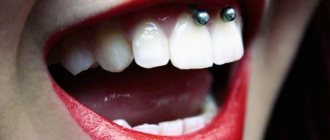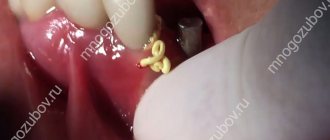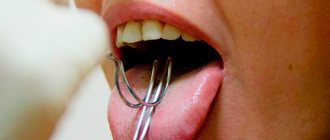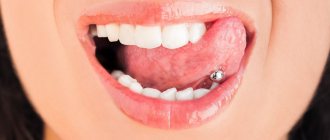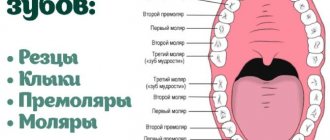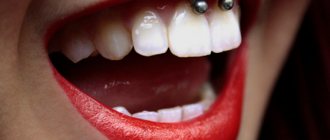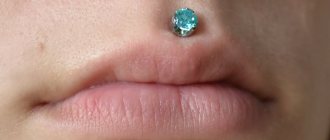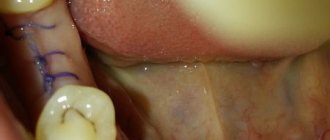Lip piercing: what is it and cost
A similar lip piercing service can be obtained at any beauty salon for a fairly reasonable price.
Before making a final decision on the advisability of such manipulation with your face, it is worth understanding what piercing is, what types and places of punctures are considered as painless and safe as possible, and also how to choose the right jewelry for a “broken” lip so that it does not interfere with normal healing wounds after breaking the integrity of the skin.
Lip piercing means a piercing of the lower or upper lip, followed by attaching jewelry to the “pierced place.” Due to the absence of vital points, nerve endings, and large blood vessels in the areas of the body in question, such manipulation is considered as safe as possible.
Lip piercing, as statistics show, can be available to a person at any age and of any gender, as evidenced by various photos on the Internet depicting older people with tattoos and piercings. This procedure has no direct contraindications related to gender or age.
If necessary, for example, at the request of the employer, the earring can be easily and painlessly removed from the lip. Wearers of jewelry of this type also note that with a long “break” in wearing earrings, you can practically return your face to its original appearance, since the “punched” hole is 99% overgrown, leaving behind the smallest point at the place where the miniature metal structure is attached.
Possible consequences
Piercing, like any violation of tissue integrity, can lead to quite unpleasant and even dangerous consequences. Risks that accompany lip piercing procedures include:
- The possibility of touching a nerve ending, which may appear immediately or after some time. In this regard, a change in human facial expressions is possible.
- Prolonged healing is possible. In this case, you will need to see a doctor to adjust the process.
- The likelihood of contracting infectious diseases, HIV or hepatitis. This happens if the master does not process the instruments after the punctures.
- Possibility of damaging tooth enamel and gums. This factor most often manifests itself when using an underlip piercing.
But despite the fact that the possible consequences are quite frightening, they can be avoided. It is enough to contact a competent specialist and follow all recommendations. Then the piercing on your lips will serve exactly the purpose you intended.
Types of piercing
Lip piercing, photos of examples of which can be found in the vast majority of beauty salons, is traditionally classified into subtypes. In distinguishing between “piercings”, craftsmen base their decisions on the place chosen for attaching the earring, as well as the jewelry itself.
The most popular are:
- Snake bite. This procedure involves “creating” two symmetrical punctures located on both sides of the lip, most often the lower one. Such piercing is not chosen by every person who decides to decorate himself, due to the complexity and duration of the body decoration process under consideration.
- Monroe. This type of earring fastening has a telling name, specially created to evoke associations with the actress of the last century - Marilyn Monroe. The essence of this “parallel” is that the Monroe piercing is done above the upper lip, and precisely on the left, exactly where Marilyn Monroe had her famous birthmark. Decoration in this place adds tenderness and femininity to its wearer.
- Madonna. Lip piercing, for the most part similar in principle to the above-described “Monroe”, but differing solely in the placement of the decoration. So, if “Monroe” is decorated on the left side above the upper lip, then “Madonna” is placed on the right.
- "Dahlia". This type of piercing involves simultaneous piercing of holes for further fastening of earrings on both sides above the upper lip. In other words, the owner of the “Dahlia” possesses both the “Monroe” and the “Madonna” described above.
- "Jellyfish". This name for the procedure is traditionally used in the context of the localization of the “broken” area under the nasal septum, in the middle of the labial “philtrum”.
- "Bridle". The telling name, in this case, indicates the piercing of the frenulum of the tongue itself. Due to its invisibility, which is considered unacceptable for young people who want to stand out, this type of piercing has recently been losing its once high popularity.
Traditionally, the decoration is an earring - labret, located vertically or horizontally. This decoration is an accessory in the form of a small barbell with a ball at the end. Labret is rightfully considered one of the types of piercings that delivers a minimum of pain to the owner when it is inserted into a specially designed hole in the lip.
Given this fact, the use of various types of labret is most common among those for whom such a “puncture” will be the first. In the vast majority of cases, the metal “bar” is inserted in the direction from bottom to top.
Based on approximately the same complexity of the piercing process in all the cases described above, the price for them is also identical.
In top beauty salons or tattoo studios, a master will ask from 1000 to 2000 rubles for a lip piercing. The standard price already includes a preliminary consultation on caring for the piercing, possible complications, a “medical” earring and “punching” a hole in the lip area to place jewelry in it.
Why get a piercing
It is believed that when people first meet, they look at their eyes and lips.
Therefore, lips are one of the most important parts of the face; their condition and appearance greatly influence the overall attractiveness. Therefore, lip piercing allows you to emphasize their graceful shape and highlight other positive features of this part of the face. In any case, an unusual decoration on the lip will attract attention and improve your appearance. Historically, piercing is one of the oldest ways to decorate the body. Lip earrings were used by representatives of many nationalities; they made it possible to demonstrate belonging to a certain clan and emphasize the desired character traits. Even now, many tribes in Africa and Australia pierce their lips and use various decorations.
In the modern world, piercing has lost its traditional meaning and has become a tribute to fashion and a way to emphasize one’s beauty and unique style.
Contraindications
Lip piercing, photos of which certainly impress people of all ages with their originality, have a number of serious contraindications, in particular:
- deviations revealed by a blood test associated with differences from generally accepted indicators of blood clotting;
- the presence of chronic diseases of any etymology, especially during relapses;
- increased body temperature or “jumps” in blood pressure;
- pregnancy;
- lactation period.
If you have at least one of the above “illnesses,” it is advisable to postpone or completely abandon the idea of piercing. Otherwise, the consequences for human health and life may be unpredictable and even require significant medical intervention.
Possible complications and consequences
Piercing is a process that grossly violates the integrity of the skin, which over time can lead to certain complications for its owner.
In addition to the obvious potential danger of infection when piercing a hole in the lip for an earring, common undesirable consequences also include:
- significant damage to tooth enamel, leading to increased sensitivity and, as a result, tooth destruction;
- the occurrence of allergic reactions, the initiator of which may be the material used in the production of jewelry, a non-sterile needle or a solution for disinfecting the puncture site;
- incorrect “fusion” of holes for earrings. Unfortunately, such a consequence is extremely common among “beginners” who pierce their lips and others. It is worth emphasizing that when faced with the described fact, only surgical intervention can correct the situation. Accordingly, it is necessary to carefully choose “your” master, who has extensive experience and a serious approach to business;
- damage to secondary nerve endings, resulting in particular in the “death” of receptors responsible for recognizing the temperature of a dish or even its taste.
Features and contraindications
Monroe piercings are usually performed using a labret with an elongated barbell. Once the piercing has healed, the size of the barbell is adjusted to suit the thickness of the client's lips. On the outside you can see a nozzle made of stone or in the form of a metal ball, which is not only a decoration, but also a fastening mechanism.
Of all the known types of piercing, Monroe is considered relatively painless because there are not many nerve endings at the piercing site. Having more delicate and elastic skin than men, women usually tolerate the procedure much easier. However, we recommend that our readers have their piercing done exclusively in a salon by an experienced piercer, where it is possible to give an anesthetic injection.
We would also like to draw your attention to contraindications.
These include:
- Exacerbation of any chronic diseases (gastritis, ulcers, pancreatitis, sinusitis, rheumatism, otitis media).
- Poor blood clotting.
- Severe skin diseases of a systemic nature (lupus erythematosus, psoriasis, etc.)
- In women - menstruation, pregnancy, breastfeeding.
- Tendency to the appearance of keloid scars.
- Hepatitis groups B and C.
- Diabetes.
- An allergic reaction to metal or drugs used during the procedure (painkillers of the lidocaine group).
- Alcohol/drug intoxication and its consequences.
- Mental disorders, nervous disorders.
- Previously suffered traumatic brain injuries.
- A common cold accompanied by a high fever.
These contraindications apply to any type of piercing, and Monroe is no exception. Specifically in our case, diseases of the oral cavity, teeth, and gums are also contraindications. Therefore, before making a decision, you should consult your dentist.
Lip piercing site
Lip piercing, photos of which can be found in huge numbers on the Internet, can be localized not only directly in the specified area, but also in the nearby area of the face.
The most popular places for punctures among connoisseurs of the considered art of decorating the body are:
- Above the lips. In most cases, girls choose to pierce the area above the upper lip. This fact is due to the maximum painlessness and speed of the process, as well as the creation of a femininity effect by simulating a mole with metal jewelry.
- Upper lip. Upper lip piercing is considered the most optimal option for those who have not fully decided on the need to become its owner. Due to the good regenerative properties of the skin of the lips, a hole “punched” in this area heals without a trace if left for a long time without jewelry inserted into it.
- Underlip. Lower lip piercing is considered relatively painful and often involves two symmetrical holes. Considering the long duration of the process, as well as the presence of nerve endings in the area in question, the choice of lower lip piercing is made by people with a high pain threshold or those who are ready to make “any sacrifice” for the sake of their own concept of beauty.
- Labial frenulum (“Smile”). This type of piercing is losing its former popularity in the modern world. A labial frenulum piercing is considered “intimate”, since it can only be seen by the person to whom the owner of the piercing decides to demonstrate it. Despite the latest trends that require the maximum shocking appearance of young people, loyal “fans” of the “smiley” remain people whose official position does not allow them to wear earrings in remarkable places, in particular on the face.
There are things to think about
Yes, a pierced lip looks quite unusual. However, before you dare to take this step, you should pay attention to some nuances that, quite possibly, will make you change your mind or postpone going to the salon for an indefinite time:
- Medical indicators. Even simple rashes during a seasonal exacerbation of ARVI can become the No. 1 reason that does not allow getting a piercing under the lip. Eczema, diabetes, epilepsy, pregnancy and lactation, as well as allergies to metals - all of these are serious medical contraindications that prevent piercing. It is also better for girls during menstruation to refrain from going to the salon for a while.
- Appropriate dress code. Do not forget that piercing is a clear manifestation of informal style. If a girl or guy works in a reputable company where business negotiations are often required, piercing will make a negative impression on the interlocutor.
- Competent choice of master and salon. This is where it gets serious – this issue should be approached with special care. The lack of a license and certificate is a sign that this place should be avoided.
Interesting: Eyebrow piercing: how the piercing is done, types. Care and selection of decoration
Many people are shy in front of the salon door, fearing that the procedure will be painful. In fact, piercing the upper or lower lip is not as scary as it seems at first glance. If you evaluate the painful sensations during the process of creating a piercing, you can give 6 points out of a possible 10.
In addition, a lip piercing heals very quickly - the tissue in the mouth area is soft and thin, devoid of blood vessels and capillaries. This means that the experience of a professional master will allow you to quickly and efficiently complete the procedure.
Earrings and piercing jewelry
Having decided on the desired location for the lip piercing, the next important issue to be resolved is related to the choice of jewelry intended to be placed in the “punched” hole. Most types of piercings involve choosing a specific type of earring, but there are also situations where you have to base your decision solely on your own preferences.
In such cases, the “favorites” among decorations often become:
- labrets (the design implies the presence of a flat surface, traditionally located on the mucous side of the lip; a barbell; a decorative “cap”, which can be either an ordinary metal ball or rhinestones or diamonds);
- rods (they have an almost identical design with labrets, differing only in the presence of balls as “caps” on both sides, and not on one, as in the first case);
- spiral (outwardly it is a small fragment of a coil of a spring, often decorated with stones at both ends, due to their simultaneous fastening “in plain sight”);
- rings, including segment ones (used exclusively to decorate the internal cavity of the mouth, in particular the frenulum, due to the impossibility of attaching them, for example, above the upper lip. Using segment rings, the owner of the piercing has the opportunity to divide them into components (segments) to give even greater extraordinary appearance);
- “flies” or “microbananas” (represent a curved labret used by craftsmen when creating piercings in the “Monroe” or “Madonna” style);
- circulars (have an appearance similar to traditional rings, differing in the presence of threaded connections along the edges).
As can be seen from the types of piercing jewelry listed above, the use of a specific earring shape or mount must be carefully thought out and must be agreed upon with a competent piercer who has extensive experience in this field.
A competent specialist should be able to give practical advice on choosing the most suitable jewelry option , which subsequently will not cause pain to its owner while wearing it directly in the lip.
Piercing procedure and aftercare
Among the most common types of piercings among girls, the Monroe piercing is the most popular. This type of body art allows you to add a touch of coquetry and grace to your expression, emphasizing the smooth features of your face and the swelling of your lips.
The puncture is quite simple:
- First, the master treats the hole and tools with an antiseptic.
- After this, a mark is made on the lip - its location is adjusted based on the client’s wishes.
- Then, using surgical forceps, the lip is clamped , and with a quick, confident movement, the needle is inserted along with the catheter, in the place of which the earring is subsequently installed.
This is how almost all types of body art are performed. It doesn’t matter whether the lip piercing is on the side or the bottom – what matters is the experience and professionalism of the master, as well as further manipulations that will allow you to soon enjoy the original decoration on your face.
Interesting: Navel piercing: how to do it and how to care for the piercing. Decoration selection
Piercing Care
How to care for a lip piercing? This question arises almost immediately after completing the procedure. It should immediately be noted that piercing in the Monroe style, the photo of which eloquently demonstrates its grace, or any other type of body art is performed in just a few minutes. After the procedure, it is highly undesirable to eat or drink alcohol for 4 hours. You should also avoid smoking for the next few hours after the puncture.
Does it hurt to get your lip pierced? Not really. On the pain scale, piercings in the “Dahlia” or “Madonna” style can be rated 6 points out of a possible 10.
In the first 72 hours, there may be slight bleeding in the puncture area, swelling of the lip and soreness. Immediately complete healing of the wound will occur within 1-2 months. At this time it is advisable:
- Drink B vitamins;
- Adhere to a special diet - lean on soups and cereals, give up spicy, sour and salty foods (you will understand why when you try to eat a lemon immediately after the puncture). You should also avoid drinking too hot or cold drinks.
- You should not remove the jewelry before the wound has completely healed.
- You should not touch your lips with dirty hands until it becomes clear that the puncture site has completely healed.
If you follow all the above recommendations and there are no medical indicators, you can safely go to the salon to get an original Monroe-style piercing.
The consequences of this procedure are extremely rare when it comes to the professional work of a master. The only thing to be wary of is damage to the enamel if the earring is placed close to the surface of the teeth.
Jewelry material
Lip piercings, photos of which are used as examples of the piercing artist’s own work, do not convey the existing qualitative difference between the materials used in the production of jewelry.
The safest and most affordable products are made from:
- gold;
- silver;
- become;
- black steel;
- titanium;
- black titanium
- bioplastic;
- PTFE;
- organic materials, in particular wood;
- bioflex.
How to make a Monroe (Madonna) piercing at home?
Monroe lip piercing can be done at home. But remember - this is a risk!
So, you need to go to any nearest pharmacy and buy a catheter needle. What is a catheter? A catheter is a tube-shaped instrument. At the pharmacy you need to ask for a large catheter.
Be sure to treat the skin and earring with alcohol and disinfect them. There is no need to process the needle, because it is sterile.
Pierce the front side of the lip with a needle and insert the labret. You need to wash it like this:
- Washed on one side;
- Washed the second side;
- Wait for it to dry completely (required).
Which decoration is better to put first?
As the first jewelry inserted into the “freshly pierced” hole, experienced piercers recommend using a labret with an extended barbell made of a medical alloy. The medical alloy minimizes the risk of infection and further development of infection at the site where the integrity of the skin is broken, and will also reduce pain after the procedure itself.
The elongated rod of the “primary labret,” in turn, will ensure comfortable wearing of the jewelry in case of existing swelling , under favorable conditions for wound healing, which persists for several days after the immediate “breaking through” of the lip.
Using other types of earrings for a “fresh” piercing can provoke painful sensations during skin regeneration, and also create a risk of damage to the “hole” itself, due to the possibility of touching, pulling, or catching on an earring with a “complex” design.
Life after a puncture. Care
Monroe is a piercing that should not be left unattended. If you decide to pierce your upper lip, then be prepared to take very good care of it. The surface and inner part of the lip must be treated with an antiseptic. Thanks to this procedure, you prevent the appearance of various scars on the skin of the face. If you take proper care of your piercing, there will be no scars at all. Here are some tips:
- After piercing (for four hours), do not try to smoke, drink alcohol or eat. You will experience a very noticeable change in the quality of diction, but do not be alarmed - this will only last for 3-4 days;
- Do not eat citrus fruits for 5 days;
- You are forbidden to eat sweet, salty, bitter, cold and hot.
Main stages of the procedure
The lip piercing procedure is relatively short and does not require special preparation, with the exception of the basic rules prohibiting the consumption of alcohol on the eve and on the day of the “creation” of the piercing.
Photo of making a lip piercing.
The basic stages of the lip decoration process are:
- Reducing salivation by “plugging” large salivary glands located under the tongue with a cotton pad or a special “suction” device.
- Treatment of the future piercing site. Hydrogen peroxide or Chlorhexidine is traditionally used as a disinfectant.
- Preparation of lips. Depending on the area being pierced, the upper lip is strongly pulled upward to pierce the frenulum, or with the help of special forceps it is “fixed” in a position convenient for the master.
- Puncture. Using a sterile catheter or a thin long needle from a traditional syringe, a straight line is inserted into the lip, piercing it through and resulting in a hole for future attachment of jewelry.
- “Installation” of the earrings. Having made sure that the puncture process was performed correctly, and also that the resulting hole is through, the master inserts a pre-disinfected rod into the lip, securing it on both sides.
- Final treatment of the oral cavity. At the final stage of “creating” the piercing, experienced craftsmen “rinse” the patient’s mouth with “Miramistin” and also generously “moisten” the place where the jewelry is attached with hydrogen peroxide.
What do people think?
A lot of people really don't like piercings. Moreover, there are also individuals who insult people who have piercings anywhere in their body. Most people perceive piercing as an element of some subculture. They believe that it is harmful to health - both physical and moral.
There are times when the process of piercing any part of the body can be painful and even very painful, but this is rare. Most often, the earring can be removed, but it is not a fact that the piercing will not leave a scar. Monroe's piercing is no exception.
Monroe's piercing receives mixed reviews. Some are for it, but many are against it. First of all, you need to listen to your own opinion.
Caring for your lip piercing site
Upon completion of the above process, the client is traditionally given recommendations for further care of the piercing, which are necessary to follow without fail over the next few weeks.
During the first two weeks, the owner of a lip decoration should not forget about:
- Rinsing the mouth with saline or another substance recommended by the specialist to “cleanse” a fresh wound. During this action, it is important to carefully remove “mucous crusts” and particles of “dead” skin from the primary labret, which interfere with the rapid healing of the “broken” area.
- Treat the puncture on the outside of the lip with Miramistin or hydrogen peroxide 2-3 times a day.
After 2 weeks from the date of lip piercing, it is advisable to:
- Continue “internal” washing of the piercing 1-2 times a day, replacing the saline solution with soapy water.
- After the physiological swelling of the lip disappears, visit a piercer to replace the primary jewelry with the desired one, which has standard design sizes.
Even after the completion of the initial “healing” stage of the “pierced” piercing site, frequent replacement of earrings or their constant touching is highly discouraged.
If the jewelry placed in the recently restored skin is too mobile, its owner risks damaging the internal integrity of the mucous membrane, thereby provoking a repeat of the process of “healing” of the wound.
Care for speedy regeneration
For the first 4 hours after the procedure, you should not eat, drink, smoke, or touch the jewelry or the lip itself.
To quickly heal the puncture site, you must follow the following rules for a month:
- Follow a gentle diet (eat soft foods with a weak taste), avoid hot, sour, salty, spicy and citrus fruits.
- After eating, rinse your mouth with a disinfectant solution.
- Wash your jewelry every day with Chlorhexidine.
- Regularly treat the hole with Miramistin.
- Avoid kissing and wearing decorative cosmetics during the healing period.
B vitamins have a positive effect on regeneration. It is better to start taking the course on the day of the procedure or a little in advance.
Does it hurt to get your lip pierced?
In the vast majority of cases, a lip piercing is comparable in pain to drawing blood from a finger , and “piercing” the frenulum is considered painless.
However, for the most part, the sensations during the described process depend on the pain threshold and sensitivity of the “daredevil” skin. People who are afraid of pain when “creating” a piercing should remember that the artist can numb the site of a potential hole with special anesthetic drugs.
How does the procedure work?
Lip piercing is a minimally invasive surgical procedure that requires proper preparation. Before day “X”, you need to visit the salon so that the specialist will examine the condition of your skin and oral cavity. If there are inflamed elements in the work area, medicinal ointments are prescribed.
A couple of days before the piercing it is highly recommended:
- Do not drink energy drinks or coffee.
- Refrain from drinking alcoholic beverages, including those with low alcohol content.
- Eliminate food supplements containing garlic extract, ginseng and other active substances from your diet.
- Avoid taking acetylsalicylic acid, Naproxen, vitamin E, Ibuprofen. It is not advisable to continue treatment with antibiotics, but their cancellation is permitted only in consultation with the attending physician.
- Start taking vitamin K. You can get it through special supplements or from food; sources include cabbage, Brussels sprouts, cauliflower, bananas, pumpkin, and olive oil.
The puncture procedure step by step:
- The client is on the couch in a comfortable position. The face is positioned towards the lamps and the cosmetologist.
- The side and place of piercing are selected and markings are made.
- The skin is treated with an antiseptic. Reusable instruments and earrings must be disinfected in a special autoclave. The master works in gloves treated with an antiseptic.
- At the client's request, pain relief is performed using subcutaneous injection of lidocaine or local anesthetics. The piercing is painful, but it lasts a couple of minutes and many people can withstand these unpleasant sensations without medications.
- The upper puncture is performed with a needle equipped with a catheter. Using a surgical clamp with a hole, the lip is grabbed and slightly moved to the side so that the needle passes sideways and does not injure the gum.
- The jewelry is inserted into the free edge of the catheter and inserted into the hole. The earring is fixed inside the wound using tweezers.
All manipulations take an average of 10-15 minutes.
How long does it take for a pierced lip to heal?
Complete healing of the wound occurs approximately 3 - 4 weeks after the procedure. This time is enough to relieve swelling of the “broken” area, “tighten” the damaged mucosa, and also “accept” the foreign object (in this case, the primary labret) by the body.
There are cases when, due to certain circumstances, healing was delayed until the infection that got inside the hole was eliminated, for example, with street dust or due to non-compliance with the recommendations for the initial treatment of the lip puncture site.
However, in any of the listed cases, skin regeneration after the “creation” of the piercing did not take more than 1.5 months and did not require special energy expenditure on the part of its owner.
Considering the above information, lip piercing cannot be considered a hazardous procedure. By following basic safety rules, as well as recommendations for caring for the piercing site, the owner of the jewelry will be able to join the ranks of happy owners of piercings depicted in numerous photos on the Internet and thematic glossy magazines.
Preparing for piercing
A few days before the procedure it is recommended:
- Treat the future puncture site with soothing ointments if there are areas of inflammation or irritation;
- Do not drink alcoholic beverages;
- Do not take aspirin and vitamin E, naproxen and ibuprofen, or any antibiotics. If you are sick, it is better to postpone the procedure until complete recovery;
- Exclude coffee and green tea, energy drinks, garlic and ginseng from the menu;
- Add vitamin K to your diet - dishes with cabbage, pumpkin, olive oil, bananas, etc.;
- Brush your teeth especially carefully, or even get a professional cleaning from your dentist.
